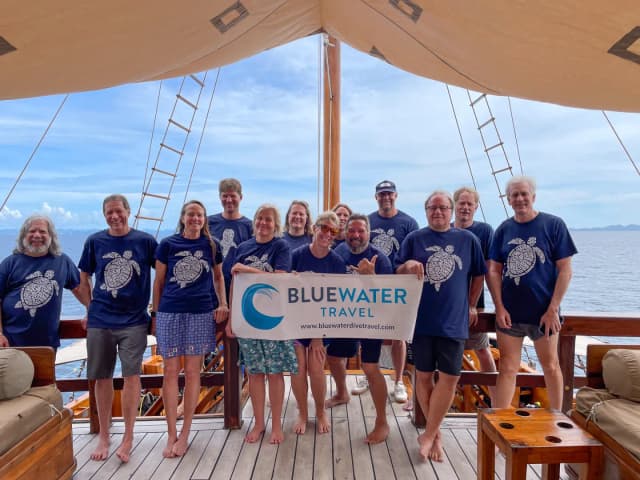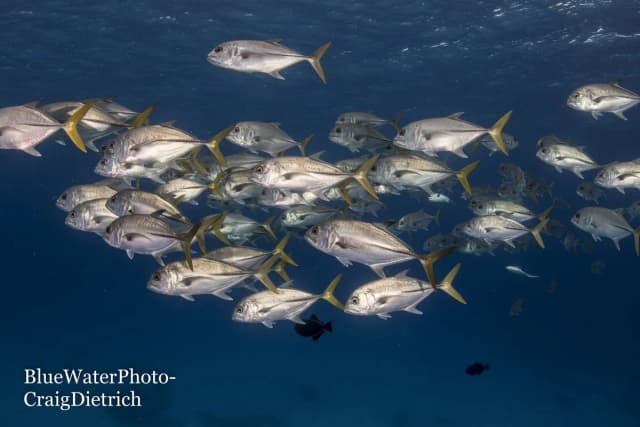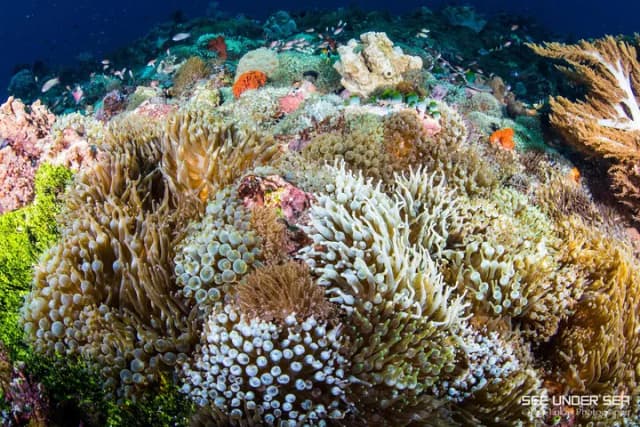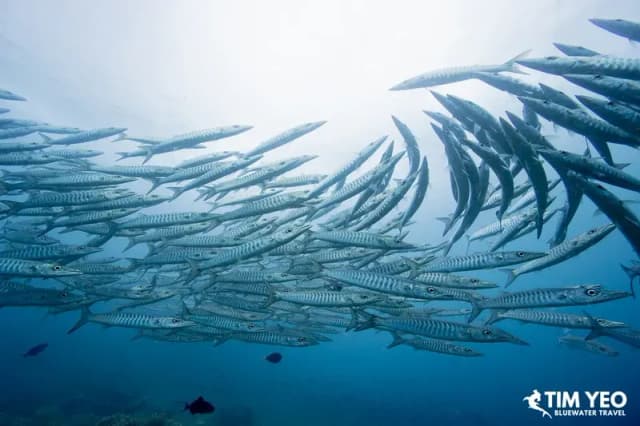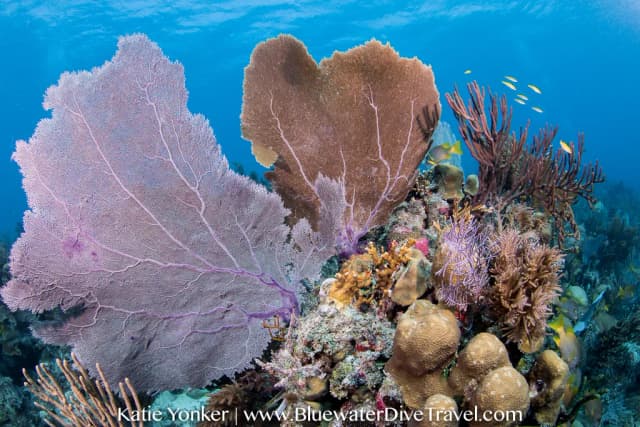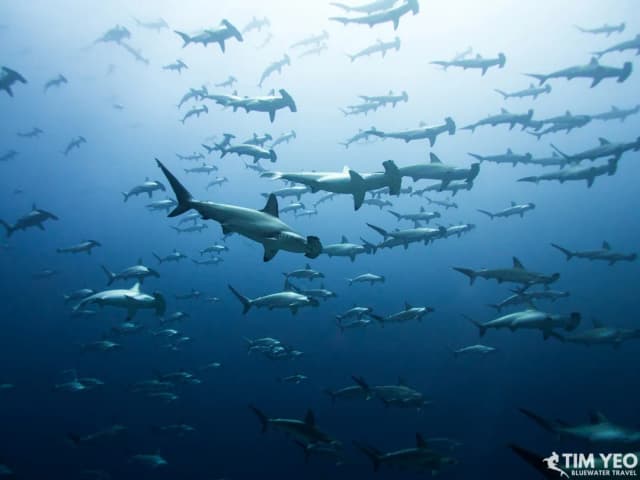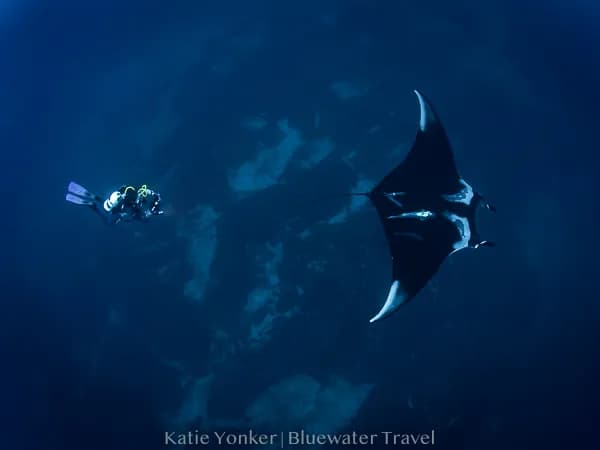Best Diving in the Caribbean - Top 12
Offering calm and warm waters, beautiful white sand beaches, and an incredible variety of small and large marine life, the Caribbean is, without doubt, a huge favorite for scuba divers. What's more, most of the areas listed below can be easily accessed from major cities in North America!
However, the Caribbean is a massive and diverse area, and deciding where to dive can be overwhelming. To help you choose, we've picked our top 12 locations for the best diving in the Caribbean.
Top Scuba Diving Spots In The Caribbean
1. Bonaire
Bonaire has a strong reputation as the world's capital of shore diving, and for good reason! Apart from having more than 60 sites accessible from the shore, and over 20 others accessible by boat at Klein Bonaire, Bonaire offers diving freedom like nowhere else in the world.
The Shore Diving Capital Of The World
To give you an idea, the dive resorts in Bonaire are famous for offering unlimited shore diving packages AND 'Drive and Dive' packages. You drive your rental car into your dive shop's drive-thru service, and their staff will load new tanks into your car! This means that you can do unguided dives pretty much where you want when you want. Of course, guided dives are possible too. Explore the top 10 dive sites in Bonaire to plan your perfect diving itinerary.

Be sure to include Salt Pier in your Bonaire itinerary for a unique dive with lots of schooling fish. Keep an eye out for a large tarpon when you're there! Photo: Kadu Pinheiro.
The marine life variety in Bonaire is no less exciting, considering that this area is the pioneer of marine protection in the Caribbean which hosts over 340 fish and 57 coral species and countless other species. Its reefs are teeming with large sponges, sea fans, small fish, and critters.
The list of sea life that you can encounter while diving Bonaire includes angelfish, butterflyfish, various seahorses, crabs, and shrimps. While it's not known for bigger marine life, scuba divers often see turtles, barracudas, and large tarpon.
Bonaire is also located outside the hurricane belt, making it accessible to divers pretty much all year round!
View our Bonaire dive resorts page for resort options and a guide to the various resort areas or learn more about diving Bonaire.
Practical Information
- Nearest Airport: Bonaire (BON). Easily accessible from major cities in North America and Europe.
- Diving Season: Year-round, with light showers through November - January.
- Water Temperatures: 80-86F (27-30C), peaking around August - October.
- Difficulty: Most of the sites are beginner-friendly.
- Non-Diving Activities: To name a few, golfing, thorny hiking in a park with lots of cactuses, visiting a limestone cave you can snorkel in, and going to the butterfly museum.
2. Cozumel & Riviera Maya, Mexico
Isla Cozumel, in Mexico's Caribbean Sea, is a terrific year-round scuba diving destination, with excellent yet easy drift dives, stellar visibility, colorful sponges, lots of fish, and a great variety of marine life. On a typical Cozumel dive trip, you will likely see turtles, moray eels, nurse sharks, and lots of colorful tropical fish. Eagle rays and blacktip reef sharks are also commonly seen.
Excellent Drift Diving, Beautiful Corals, & Diverse Marine Life!
In and out of the sea, the island itself is a marvel, offering a wide array for scuba divers and non-divers alike, such as swimming with dolphins, fantastic snorkeling, a visit to Mayan ruins, bar hopping, and more. This wonderful variety, accessibility, as well as affordability, make Cozumel a huge favorite for international travelers of all ages.

If cavern diving is what you're into, the Riviera Maya in the Yucatn Peninsula is where you want to be. The peninsula, which was once buried beneath the ocean's surface, is now brimming with various flooded caves and caverns, known as cenotes. Scuba divers can now swim around to marvel at these ancient formations, an experience that many describe as magical.
It's also easy to combine your cenote diving trip around the Riviera Maya with a trip to many other different areas in the Yucatan Peninsula, such as Banco Chincorro, where you can safely swim among American crocodiles. Check out Bluewater Travel's Katie Yonker's experience on our 2019 Crocodiles & Cenotes Trip to learn more!
Interested in diving Cozumel? View our Cozumel dive resorts page for land-based options and a guide to the various resort areas or learn more about diving Cozumel.
Read our list of the top 10 dive sites in Cozumel!
Find out about diving in other great Mexican destinations.
Practical Information
- Nearest Airport: Cozumel International Airport (CZM) if you want to dive Cozumel and Cancun International Airport (CUN) for the Riviera Maya.
- Diving Season: Year-round. High season: December to April.
- Water Temperature: Avg. 25C (77F) in December-March and 29C (85F) in May-July.
- Skill Level: Beginner to Advanced. Cenote/cavern diving is more suitable for more experienced divers who are comfortable with their buoyancy.
- Non-Diving Activities: Parasailing, fishing, kayaking, snorkeling, hiking, tequila-tasting tour, eco-jungle or lagoon tours, Mayan ruin visit, and the list goes on!
3. Jardines De La Reina, Cuba
Offering amazing shark dives, pristine reefs, and thrilling saltwater crocodile encounters, Jardines de la Reina is definitely one of the Caribbean's finest dive destinations. Sightings of large Caribbean reef sharks and silky sharks are pretty much guaranteed, and you might see hammerhead, nurse, lemon, and blacktip sharks too, depending on the time of year.
World-Class Shark Diving, Saltwater Crocodiles, & Pristine Reefs
Then, as previously mentioned, you've got the whole snorkeling with crocs experience. Yes, Jardines de la Reina is one of the very few places in the world where you can safely get up close in the water with American saltwater crocodiles. If you dont believe it, see our travel advisor Tim Yeos photos and story from his sharks and crocs trip to Cuba.

To top it all off, Jardines de la Reina also holds a reputation as one of the best-preserved marine areas in the world, and as a result, the reefs are very healthy and teeming with life. Sharks and crocodiles aside, you can see massive groupers, loggerhead, hawksbill and green turtles, snappers, and various colorful tropical fish and loads of smaller critters.
Do take note that only liveaboards have permission for diving activities in the marine park.
View liveaboard options on our guide to diving Cuba and read about our Eco Dive Center Cuba Trip Recap.
Interested in shark diving? Discover our favorite shark diving destinations.
Practical Information
- Nearest Airport: Havanas Jose Marti International Airport (HAV).
- Diving Season: The best time to dive Cuba's Jardines de la Reina is during the dry season, from November to late April, as this time has the most ideal visibility and sea conditions.
- Water Temperatures: Ranges from around 22C (72F) in December to 29C (84F) in July.
- Skill Level: There is something for every level of diver in Cuba, from beginner to advanced divers.
- Non-Diving Activities: Cuba offers a variety of water sports, and on the island itself, you can go on a number of tours including several to the historical city of Havana, play golf, go on a hike or horseback riding.
4. Cayman Islands
The Cayman Islands have so much diversity to offer to scuba divers, that some locals even say that there is a different dive site for every day of the year here! Take your pick between the three islands: Grand Cayman, the largest, most popular and well-developed island with so many things to do; Little Cayman, the most untouched and least populated; and Cayman Brac, which is somewhat in between, not too quiet and not too crowded!
Walls, Wrecks, & Amazing Diversity
Grand Cayman offers a vast number of interesting wreck and wall sites, as well as Stingray City, where the rays are fed squid by hand in 12 feet of water. A unique experience that's not to be missed! Be sure to include the world-famous 251-foot (78-meter) shipwreck USS Kittiwake in your itinerary too.
The most secluded and smallest out of three, Little Cayman offers its own charm, with over 50 dive sites to choose from, including the famous Bloody Bay Wall Marine Park, best-known for its amazing colors, steep drop-offs, and dramatic swim-throughs.

Check out our Grand Cayman Trip Report 2019 to learn what it's like to dive the area.
The dives off Cayman Brac are quite similar to Grand Cayman, with lots of beautiful wrecks and wall sites to explore, including a must-dive Russian destroyer wreck, the MV Capt. Keith Tibbetts.
Wherever you decide to dive, expect to see a lot of colorful large sponges underwater and a good mix of small and large marine animals such as moray eels, turtles, groupers, tarpon, nurse sharks, jawfish, angelfish, nudibranchs, and pufferfish.
Land-based diving is the norm here, but divers can explore the best sites of all three islands in a single visit with a trip aboard the Cayman Aggressor V, which is the only liveaboard in the area to date.
Book a trip on the Cayman Aggressor V, view our selection of dive resorts in the Cayman Islands, or learn more about diving the Cayman Islands!
Practical Information
- Nearest Airport: Owen Roberts International Airport on Grand Cayman (GCM) which is a 70-minute flight away from Miami. From Grand Cayman, you can transfer to Little Cayman (LYB) or Cayman Brac (CYB).
- Diving Season: Year-round. Hurricane season is June 1st - November 30th, but uncommon. High season: Mid-December to Mid-April.
- Water Temperatures: 78 to 82F (26-28C).
- Skill Level: Beginner to Advanced. There are so many sites you can choose from!
- Non-Diving Activities: Golfing, tours aplenty, from eco-tours to walking tours to historical tours. Depending on the time of year, you may get to see some amazing festivals as well.
5. Bahamas
A can't miss in the Caribbean, the Bahamas is hands down one of the best shark diving destinations in the world. Divers can get up close and dive cage-free with various large shark species in calm waters with crystal clear visibility, which makes the Bahamas an ideal destination for all kinds of divers: underwater photographers, novice divers, you name it!
Sharks, Sharks, Sharks!!!
Head to Tiger Beach on Grand Bahamas' West End to safely dive up close with tiger sharks around the months of October-May. Keep an eye out for lemon sharks, Caribbean reef sharks, nurse sharks, and even hammerheads!

Want to see sharks and dolphins? Go to Bimini around January-March to see great hammerhead sharks alongside Caribbean reef sharks and nurse sharks, and throw in a wild dolphin excursion while you're there.
You can also plan a visit to the pristine Cat Island to dive with massive oceanic whitetip sharks in April-June.
A good portion of the diving in the Bahamas is land-based, with many great dive tour operators offering various 'dive and stay' packages that can easily be customized based on your needs and preferences.
Liveaboards to the Bahamas are also an excellent option many have chosen, with some of the boats conveniently departing from Florida and crossing over to Bahamian waters. There's a liveaboard for everyonetake your pick from budget-friendly to luxury!
View our selection of Bahamas liveaboards and dive tour operators. Consult us to have a trip arranged for you at no additional cost!
If you're interested in sharks, you may also want to check out our top shark cage diving destinations.
Practical Information
- Nearest Airport: Lynden Pindling International Airport (NAS) in Nassau is the main international travel hub. You can take a domestic flight to the destination of your choice from this airport. Most liveaboard trips depart from Nassau.
- Diving Season: November-May/June. The islands fall within the hurricane belt, so hurricanes may be a factor between June 1 and Nov. 30 (the Atlantic hurricane season).
- Water Temperatures: 72-79F (22-26C) in December-April; 77-87F (25-30C) in May-November.
- Skill Level: Beginner to Advanced.
- Non-Diving Activities: Dolphin encounters, cultural and historical tours, snorkeling and other water sports, fishing, spas, shopping, and more!
6. Roatan, Honduras
Roatn is the largest island among the Bay Islands off Honduras east coast, which also includes the popular Utila and some other islands' cays. Divers love Roatn for its inexpensive diving and laid-back atmosphere. Roatn's waters have close to 100 named dive sites, ranging from wrecks and caves to lots of excellent walls.
Laid-Back Caribbean Destination with Excellent Diving
The marine life here includes many of the usual suspects in the Caribbean waters, such as big groupers, hawksbill turtles, eagle rays, various sharks, and dolphins. You can also find smaller animals such as cleaner shrimps, various seahorses, starfish, lobster, squids, and unfortunately plenty of lionfish as well.

Photo: Kadu Pinheiro
While most of the diving is land-based, avid divers can opt for a liveaboard trip on the Roatn Aggressor, which is the only liveaboard operating in the area at present. And for those who've already been to Roatn and enjoyed the diving, a return trip via the Roatn Aggressor is a must, since it visits Coco's Sea Mount and Cayos Cochinossites not visited by day boats.
Book a trip on the Roatn Aggressor or view dive resort options in the Cayman Islands.
Practical Information
- Nearest Airport: Juan Manuel Glvez Roatn International Airport (RTB).
- Diving Season: Year-round. When a swell or wind occurs on one side of the island, the opposite side is usually calm. November-January gets the most rain, and hurricanes are uncommon. Learn why we love diving Roatan in April.
- Water Temperatures: 81-88F (27-31C) year-round.
- Skill Level: Beginner to Advanced.
- Non-Diving Activities: Topside, Roatan is a nature lover's paradise, where guests can visit various birds, monkeys, and caimans, go see a butterfly garden, iguana farm, or botanical garden.
7. Turneffe Atoll, Belize
Turneffe Atoll in Belize is the largest of the three atolls that make up the worlds second-largest barrier reef. Located southeast of Ambergris Caye, it may just be the best and most beautiful dive area in the whole country. This large offshore atoll reef offers a wide variety of easy dive sites, insanely clear visibility, and very varied marine life.
Unspoiled Dive Destination With Amazing Diversity
Divers may expect to see white-spotted toadfish, eagle rays, tarpon, green morays, various reef sharks, and nurse sharks. Watch out for spotted drumfish and flamingo tongue cowries, too!
Belize, in general, is a place for both adventure seekers and those looking for a relaxing time. When you're not diving, there's a range of activities to pursue, including cave tubing, waterfall rappelling, Mayan ruin tours, and other tropical rainforest activities.
Most divers who visit Belize stay on Ambergris Caye, where there are numerous resorts and dive operations. Dive boats take day trips out to Turneffe and the Blue Hole, in addition to the numerous dive sites around Ambergris.
Alternatively, guests can choose to stay at a dive resort within the atoll, such as Turneffe Island Resort or Turneffe Flats, or stay in a different area in Belize and simply take a day trip to Turneffe Atoll. If you want to explore the various dive areas in Belize with ease, there are two liveaboard boats to choose from: Belize Aggressor III and Belize Aggressor IV.
View our selection of Belize dive resorts or Belize liveaboards. Consult us to have a trip arranged for you at no additional cost, or learn more about diving Belize.
Practical Information
- Nearest Airport: Goldson International Airport (BZE) in Belize City, where you can then continue on to your island of choice by boat.
- Diving Season: Year-round. Visit in April-May for the best overall conditions. November-April are the most popular months. Check the weather report if you intend to visit in the summer/hurricane season from June-November.
- Water Temperatures: 78-80F (25-27C) in November-April; around 84F (29C) in May-October.
- Skill Level: Beginner to Advanced.
- Non-Diving Activities: Turneffe Atoll is one of the best places in the world for fly-fishing, so you might as well give it a try while you're there. It's also well known for kayaking and has great areas for snorkeling, or you can simply enjoy the white-sand beaches!
8. Silver Bank, Dominican Republic
The Dominican Republic may not come to mind as a popular dive destination, but it offers the incredible opportunity to encounter humpback whales in the water.
The Place To Swim With Humpback Whales In The Caribbean
Dominican Republic's Silver Bank is among the only three places in the world where you can safely snorkel and swim with humpback whales. A status review by the National Oceanic and Atmospheric Administration (NOAA) in 2015 announced that the Silver Bank and its neighbor Navidad Bank have the largest concentration of the North Atlantic humpback whale population known to man.
For mother humpback whales and their calves, these waters are a protective sanctuary. From January through April, you'll see them in these waters for mating, calving, and nurturing their young.
In keeping with Silver Bank being a Sanctuary for the Marine Mammals of the Dominican Republic, swimming with whales here is tightly regulated. No more than 60 visitors are allowed each week, and scuba diving is forbidden for general tourists.
As such, there are only a few liveaboards allowed in these highly protected areas. Liveaboard options include Turks & Caicos Aggressor II and Turks & Caicos Explorer II, typically visiting the Silver Bank from late January through early April. Trips book up in advance, so early booking is a must.
Practical Information
- Nearest Airport: Puerto Plata (POP). This is where the Aggressor & Explorer boats mentioned above depart from.
- Whale Season: January-April.
- Water Temperatures: Range from 28C (83F) in summer and 24C (76F) in winter.
- Non-Diving Activities: Limited to what's offered by the liveaboard operator of your choice.
9. Turks And Caicos
Turks and Caicos is an archipelago, a British Overseas Territory consisting of 40 islands, only 8 of which are inhabited.
Excellent Shark Diving & World Class Wall Sites
Most of the best sites are spread across the three main areas: Providenciales, the most popular and populated island in the country, also known as Provo; Salt Cay, which is a wonderful diving spot with many interesting wrecks, caverns, and walls; and Grand Turk, with beautiful protected plunging reefs and interesting history and culture to discover.

Our group of divers saw Caribbean reef sharks pretty much on every dive on our Turks and Caicos trip in 2019, and nurse sharks are also commonly seen. Other marine life includes schooling jacks and green turtles, orange elephant ear sponges, gray reef sharks, angelfish, eagle rays, and many others. Visibility is often excellent, and the absence of current makes photographing marine life easier.
Liveaboard diving is the way to go to explore the archipelagos many islands and diverse diving. There are only two liveaboard operators in the area: Turks & Caicos Aggressor II and Turks & Caicos Explorer II.
Diving via a resort is possible with several options available, such as Bohio Dive Resort on Grand Turk. Dive Provo is also an excellent dive operator option.
View the availability of Turks & Caicos liveaboards and book online at the best price, or consult us to have a trip arranged for you at no additional cost!
Practical Information
- Nearest Airport: Providenciales International Airport (PLS) is the main international travel hub and where liveaboard trips embark from.
- Diving Season: Year-round. Keep in mind that there are occasional showers throughout June to October. Hurricanes are not common, but do check the latest weather forecast or ask your travel advisor before planning your trip.
- Water Temperatures: Avg. 77 to 84F (25 to 30C)
- Skill Level: There is something for every diver in Turks and Caicos, from beginners to advanced divers.
- Non-Diving Activities: Depends on where you stay, but popular options include bird watching, whale watching, golfing, kayaking, and conch tasting. Your options will be more limited if you stay on a liveaboard.
10. Dominica
While not quite as frequented by tourists as other places in the Caribbean, Dominica is quickly gaining a reputation for being one of the best places in the world to visit. In 2017, Dominica made it to Lonely Planet's top 10 countries in the world to visit, and with good reason, especially for divers.
The Caribbean's Best Spot For Whale Watching
One of the things that makes Dominica so amazing, both above and below the surface of its waters, is the topography. Rugged peaks and ridges on land, along with steep underwater volcanoes, complete with pinnacles and craters galore. Furthermore, there is practically little to no current in the waters, which makes exploring those crevices very manageable!
Dominica's most famed dive site is the Champagne Reef, named after its warm bubbling water, courtesy of the geothermal vents underneath. Like many of the sites in the country, this site can be easily reached from the shore and is a great spot for night diving. You'll also find many calm shallows where you can see seahorses on corals.
In Dominica, divers will also encounter marine life such as electric rays, seahorses, frogfish, gurnards, Caribbean reef squid, sea snakes, and batfish, as well as spotted and spinner dolphins. Dominica also happens to be the mecca for whale watching in the Caribbean, with 22 species of whales in its waters, including the mighty sperm whale! Most dive resorts in Dominica will offer you opportunities to combine diving with whale watching on your tripan experience that we would highly recommend.
Dive spots in Dominica are accessible via short boat rides offered by numerous land-based tour operators around the island.
Learn more about diving Dominica.
Practical Information
- Nearest Airport: Dominica's Douglas-Charles Airport (DOM).
- Diving Season: Diving and whale watching in Dominica can be done year-round. Dominica is susceptible to hurricanes in August-October. Sperm whale sightings are more prominent throughout November-March.
- Water Temperatures: 78-80F (25-27C) in November-April; around 84F (29C) in May-October.
- Skill Level:Beginner to Advanced.
- Non-Diving Activities: Kayak tours and hiking to the island's many waterfalls are part of Dominica's topside attractions, or guests could go through Carib Territory - the Indian tribe after which the Caribbean Sea was named.
11. Curaao
Curaao is an excellent option for divers and underwater photographers seeking varied sites and rich marine life in a more tranquil setting.
One Of The Caribbean's Best-Kept Secrets
Curaao's waters host a plethora of critters to please discerning underwater macro photographers. Some of the small sea life that you can see include frogfish, pygmy angelfish (Centropyge argi), flameback angels, gobies and blennies, neck and speck clawed crabs, banded corals, scarlet, red night shrimps, and red-banded lobster. Pederson and spotted cleaner shrimps can also be found on every dive. The lettuce sea slug is the easiest nudibranch to spot and comes in three-color phases.
Divers in Curaao have many choices for both boat dives or shore dives, with over 85 dive sites consisting of interesting wrecks, walls, and healthy coral reefs.
Some popular dive sites in Curaao are Mushroom Forest and the Blue Room. In the former, the coral formations have begun to look like mushrooms as they've grown over the years, hence the name, and have amazing marine life beneath. And the latter is an underwater cavern glowing with an eerie blue light and is populated within with macro life such as glassy sweeper.
Contact usfor a consultation regarding local dive resorts or learn more aboutdiving Curaao.
Practical Information
- Nearest Airport:Curaao International Airport (CUR).
- Diving Season:Year-round. Curaao is located outside the hurricane belt.
- Water Temperatures: 78-80F (25-27C) in November-April; around 84F (29C) in May-October.
- Skill Level:Beginner to Advanced.
- Non-Diving Activities: Topside, Curaao is replete with history, with many places worth visiting, such as the floating market, and the Queen Juliana Bridge. The adventurous will not want to miss the Hato Caves, with its pools, waterfalls, limestone formations, and the famous Madonna statue.
12. Tobago, Trinidad & Tobago
Tobago, the smaller of the twin islands of Trinidad and Tobago, offers many picture-perfect beaches and is way more laidback and untouched, making it a perfect base for an idyllic scuba diving vacation.
Laidback Destination With Excellent Drift Dives
Expect thrilling drifts on most of your dives in Tobago. Amazingly healthy reefs consist of both soft and hard corals, as well as abundant marine life, big and small.
While diving Tobago, you can see huge manta rays, porcupine fish, French angelfish, blacktip reef sharks, nurse sharks, southern stingrays, Atlantic guitarfish, lobsters, eels, snappers, rainbow runners, torpedo rays, bicolor damselfish, porkfish, Bermudan chub, big eye snappers, and glass eye snappers.
Some of the must-dives in Tobago include MV Maverick, one of the most famous shipwrecks in the Caribbean, and Kelleston Drain, where the world's largest brain coral resides.
Learn more about diving Trinidad & Tobago.
Practical Information
- Nearest Airport: You can fly internationally into Piarco International Airport (POS) inTrinidad, or toANR Robinson International Airport (TAB), in Tobago.
- Diving Season:Year-round, with reduced visibility during the rainy season (July-December).
- Water Temperatures:25C-28C (78F-84F)
- Skill Level:Beginner to Advanced.
- Non-Diving Activities: The beaches are wonderful to relax in, and those who would like more strenuous activities can try hiking, mountain biking, trekking and more!
Other Great Scuba Diving Destinations In The Caribbean
As you can imagine, there are many other scuba diving destinations in the Caribbean, but the diving might not be as excellent or the diving infrastructure not as strong. However, these areas are at least worth mentioning:
- British Virgin Islands - for great wreck diving and amazing coral reefs
- Saba, St. Kitts, and St. Eustatius- an adventure in a volcanic dive environment
- Aruba - the Caribbean's premier wreck destination
- St. Vincent and the Grenadines - a muck-diving destination with amazing visibility
- Costa Rica (east coast) - tropical marine life abound in shallow sites perfect for beginners and snorkelers
- St Maarten/ St Martin - vibrant reefs and wrecks great for Open Water divers.
Are there other Caribbean dive destinations that should be on this list? Do you have questions about any of the destinations listed above? Drop us a line and well gladly answer your questions to help you plan your next dive vacation. You can also hit the live chat button on the bottom right corner of your screen to contact us!
Best Time To Dive The Caribbean
Generally speaking, the Caribbean's diving season runs year-round, keeping in mind that many of the islands could be affected by the Atlantic hurricane season which runs from June 1st to November 30th. The peak hurricane season typically lasts from mid-August to late October.
Luckily there are plenty of great islands to dive in outside of this period. Some of the best times to dive in the Caribbean are in the spring and fall months, when the weather is mild and the water is warm. The best diving conditions vary per island, and divers should keep in mind that ocean currents may affect visibility. Look into each destination's weather and diving conditions before your visit.
Wherever you decide to go, know that youll find some of the best diving in the world while diving in the Caribbean!
Book A Trip To The Caribbean
Bluewater Travel is a full-service dive-travel agency. We'll be happy to book you a dive resort or a liveaboard virtually almost anywhere in the Caribbean (and the rest of the world) at the same price, or even lower, than booking any other way.
We are experts on diving, resorts, liveaboards, and logistics in the Caribbean! Email us or leave us a message through the live chat box to start planning your trip!
Interested in liveaboards?
Let's help you get started with our Guide to Liveaboard Diving.
You may also want to check out our list of the Best Liveaboard Destinations for Beginner Scuba Divers.








